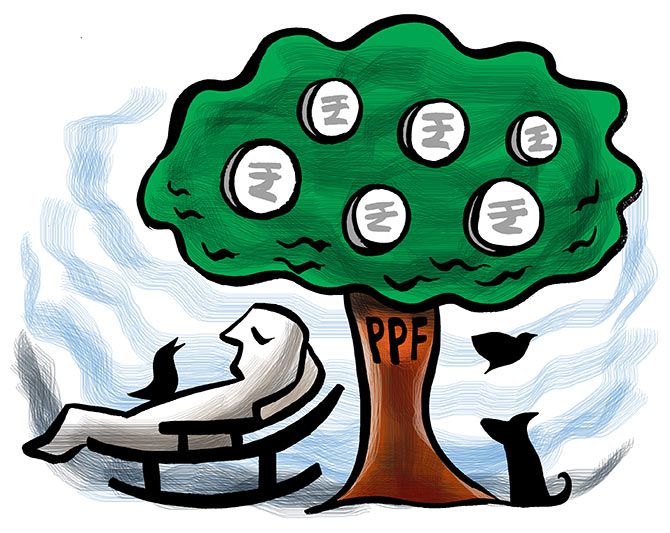The amount saved in a PPF account is actually saving for a rainy day.
God forbid, if bad days fall upon someone and debts pile up.
A fascinating excerpt from Anil Lamba's Financial Affairs Of The Common Man: Master The Art Of Personal Finance Management.
Illustration: Uttam Ghosh/Rediff.com

Open a PPF account early and there is no need to do any other retirement planning
Investing in PPF is an excellent way of saving, which also gives a tax deduction.
Even if one does not get any tax advantage by virtue of the fact that the maximum deduction available under Section 80C is being exhausted through some other investments made, it still makes ample sense to invest in PPF.
Let me explain why
The amount of deposit and the period of the account
PPF is a 15 years account. One is obliged to deposit a minimum of Rs 500 each year, and it is possible to deposit up to a maximum of Rs 150,000 as per rules in force currently.
Tax deduction, rate of interest and other benefits
The amount invested in a PPF account is eligible for a deduction under Section 80C of the Income Tax Act, subject to the conditions of the section.
The PPF account earns interest which is compounded annually.
The entire interest earned is exempt from income tax under Section 10 of the Income Tax Act, without any limits.
The entire balance in a PPF account is exempt from wealth tax. Earlier this exemption was not available to other deposits, but now even other investments and bank balances are exempt from wealth tax.
An account for a rainy day
The amount saved in a PPF account is actually saving for a rainy day. God forbid, if bad days fall upon someone and debts pile up, probably all the assets of the person can get attached.
However, no court of law in India has the power to order attachment of the balance in a PPF account and hence the debtors cannot access one's PPF account to claim the dues.
However, it does not apply to the income tax authorities and so the amount standing to the credit of a depositor in the PPF account is liable to attachment under any order of income tax authorities with respect to debt or liability incurred by the person.
The tenure
The period of 15 years is actually nothing to get concerned about, and in fact, once a person gets acquainted with its advantages s/he actually starts wishing that the account was of a longer duration.
For this purpose it is permitted, on maturity, to extend the account indefinitely in blocks of five years.
Besides, the PPF scheme follows the fiscal year (that is the period April 1 to March 31) as its accounting year. Even if you open the account on March 31, on the very next day one year is over and only fourteen years will be left.
For those of you who have not been investing in PPF and instead choose something like National Savings Certificate because of the shorter duration of maturity, I think investing in PPF can be of even shorter duration than any other investment.
How is that possible?
You open this account and for the first 10 to 12 years deposit only the bare minimum amount that is required to keep the account alive. Now in the 13th year invest the maximum permissible amount.
You will get all the advantages of investing in a PPF account like tax deduction, a pretty decent interest, tax exemption on the interest, etc., and will also get your money back in three years.
The amount deposited in the 14th year will come back in two years and the sum deposited in the 15th year will come back in one year.
It is worth opening the account just to take advantage of the 15th year of deposit. But I don't suggest you do this.
You should deposit a substantial amount each year and the real advantage of this account can be reaped if you do not withdraw the amount and let it accumulate over a number of years.
The amount deposited in the account can be different each year.
Since the minimum amount to be deposited is Rs 500, in a particular year if one does not have sufficient disposable surplus, one needs to only deposit this minimum sum to keep the account alive.
In fact if one finds even Rs 500 to be high, one can deposit Rs 42 each month since the account allows up to 12 deposits each year, one per month.
And even if Rs 42 per month pinches, I suggest don't deposit anything. But still open this account.
What will happen if you do not deposit any money? The account will lapse. Let it lapse.
If a few years later you realize the advantages of having a PPF account and if you open an account then you will have to wait another 15 years for the account to mature.
But if you open the account now and it lapses, you can revive the account by depositing Rs 500 for each year that you did not pay along with a penalty of Rs 50 for each year of default and the account gets revived.
And what if one is in dire need of money before the 15-year tenure of the account is over?
This is also nothing to worry about since the account allows a loan to be taken after the third year and there is also a withdrawal facility after the sixth year (as explained below).
Besides, it is possible to prematurely close the account after five years.
As per an amendment proposed to amend the rules of the account, investors will be allowed to withdraw their money from a PPF account in case of exigencies, such as medical emergencies or higher education needs.
Loan and withdrawal facility
Loan is admissible from the third year. The loan amount is limited to 25% of the balance at the end of two preceding years. A fresh loan is not allowed when previous loan or interest thereof is outstanding.
Interest is charged at the rate of 1% if repaid within 36 months and at 6% on the outstanding loan after 36 months.
Withdrawal is permissible every year from the 7th financial year since the year of opening, limited to one per year.
Amount of withdrawal is limited to 50% of the balance at the end of the fourth preceding year or 50% of the balance at the end of the immediate preceding year, whichever is less.
'Balance at the end of the preceding year' means the immediately preceding March 31.
Let me illustrate the withdrawal facility assuming you are depositing Rs 150,000 each year.
For the first six years withdrawal is not permitted. In the 7th year you can withdraw either 50% of Rs 900,000 (that is the balance at the end of the immediately preceding year) or 50% of Rs 450,000 (balance at the end of the fourth preceding year), whichever is lower.
So the maximum permissible withdrawal would be Rs 225,000. In the 8th year the withdrawal would be 50% of the lower of Rs 825,000 or Rs 600,000 and so on.
Now watch table 1 carefully. Do you see anything particularly attractive about it?
How much have you deposited each year? And how much is the amount of withdrawal each year after the 6th?
The amount withdrawn is more than the amount deposited each year right up to the 15th year. In other words the out of pocket investment is nil.
And so far, I have ignored interest. If you take into account the interest, the amount that you are eligible to withdraw would be substantially more than what I have illustrated.
Which means that all one has to do after the 6th year is to go to the bank, withdraw the amount permissible, deposit out of the same amount Rs 150,000, actually bring money home, and enjoy an income tax deduction.
And this can be done right up to the maturity of the account.
But I would not recommend that you do this. By all means do it if you are in need of money. But if that is not the case, then I would rather you make a fresh investment in the account each year.
That is the only way you can take maximum benefit of the PPF account.
The rate of interest on the PPF account has lately been an average of 8% (+/- 0.75 per cent).
Imagine that someone opens a PPF account, deposits Rs 150,000 each year, and renews the account every five years after the initial 15 years.
Take a look at table 2 illustrating the interest earned and the closing balance in the account after 5, 10, 14, 20 , 30, 40, 50, 60 years assuming an interest rate of 8%.
At the end of 10 years the principal amount deposited is Rs 15 lakh and the closing balance is over Rs 23 lakh.
After 20 years Rs 30 lakh is the principal and closing balance over Rs 74 lakh.
After 30 and 40 years the principal amounts of Rs 45 and 60 lakh have grown to Rs 118 lakh and Rs 420 lakh respectively.
And after fifty and sixty years the principal amounts invested are Rs 75 lakh and Rs 90 lakh and the closing balances have increased to a staggering sums of Rs 9 crore 30 lakh and 20 crore 30 lakh respectively.
Do you see the power of compounding in action here?
Which is why it is so important to open this account as early in life as possible, and to keep depositing till one is ready to retire.
Now you can also see why I was against using the amount withdrawn each year to make the deposit.
As far as possible deposit a fresh amount and the amount should stay in the PPF account for as long as possible.
One who opens a PPF account at the age of say 25 years, can easily deposit in the account for 35 years or even more.
One of the finest gifts parents can give to their child is a PPF account opened in the child's name soon after birth.
The parents can deposit money for the first 20 to 25 of the child's life and thereafter the child starts depositing in the account till the age of say 60.
Can you imagine the amount that would get accumulated?
I have always felt, that if one has systematically deposited money in a PPF account, starting relatively early in life, even if no other retirement planning has been done, this account alone can suffice.
In table 2, at the end of 35 years the closing balance is about Rs 2.79 crore and the interest earned in the year is over Rs 20 lakh.
And at the end of forty years the balance is Rs 4.20 crore and the interest is over Rs 31 lakh.
Imagine a couple, both of whom have a PPF account which at the time of their retirement has been active for 35 to 40 years, a closing balance of anywhere between Rs 2.79 crore to Rs 4.20 crore, earn interest per annum of, say, anywhere between Rs 20 lakh to Rs 30 lakh each.

By the time of retirement, most family responsibilities have been taken care of, the children are settled, the house and the car are already there.
To take care of their day to day expenses and more, they need to simply withdraw the interest component between them amounting to about Rs 50 lakh per annum which is tax-free.
And the nest egg in the form of the principal amount is safe and intact.
Now I know your immediate reaction is going to be 'What if the laws change?', or 'What if the scheme gets discontinued?' or 'What if the tax exemption is withdrawn?'
All I would like to say is, since one doesn't know the future, one can only plan on the basis of what is applicable today.
Personally, I have been strongly advocating this account for over twenty years now. And these questions were posed even 20 years ago. Till date the account is still there.
It is just the interest rate that has been revised downward (in keeping with a general reduction of interest rates on other deposits too).
All other features have actually become more attractive. Earlier a service charge at the rate of 1% was levied on withdrawals. Now there is none.
Earlier extension was permitted for five years at a time for merely three times. Now there is no restriction.
And, of course it would be a pity if, being sceptical, one were to not take advantage of this investment when 30 or 40 years later in all its glory, the account could still be around.
Excerpted from Financial Affairs Of The Common Man: Master The Art Of Personal Finance Management by Anil Lamba, with the kind permission of the publishers, Penguin Random House India.










 © 2025
© 2025